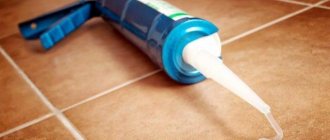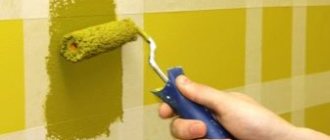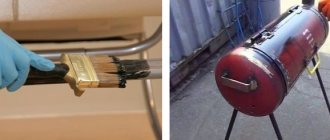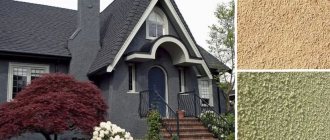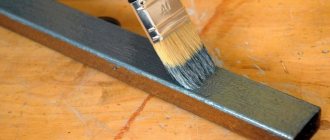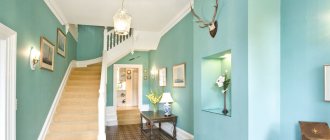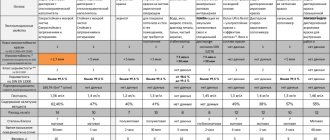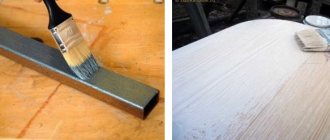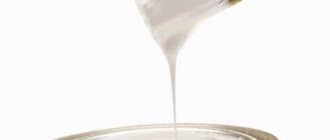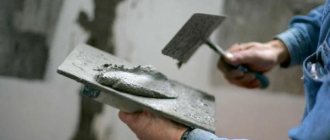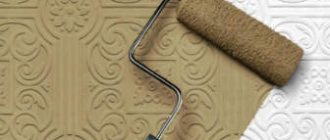Calculate the area
In order to calculate the amount of paint, you need to calculate the surface area. To do this, you need to multiply the length (6) by the width (4) of the surface to be painted (24). Such actions must be carried out on all surfaces.
- If you will cover different surfaces with different colors, it is better to calculate the area separately. You can add up the surface area covered by one color.
- The surfaces covered with white are calculated together. The surface area covered with beige must be folded.
If it is necessary to cover a surface covered with wallpaper, the principle of measuring the area does not change, but the paint consumption will differ.
Surface preparation before painting
It is very important that the surface is cleaned of old paint residues before painting; for this we recommend using chemical removers. Watch a video of how paint removers work
offers professional paint varnish removers, we recommend Docker S4, S5 removers .
- Areas where it is better to use oil paint
- Paint Removal Methods
DOCKER S4 - general construction remover of all types of paintwork
Calculation of paint per 1m2
In order to calculate paint consumption, we first study the data provided about the paint by the manufacturer. It indicates the hiding power of the paints and the dry residue. Hiding power is the ability of paint to cover the original color of the surface in one layer.
Dry residue is the composition that remains on the surface of the paint after drying. A simple formula will help you calculate paint consumption per 1 m2.
Having data on covering power and dry residue, you can calculate the most approximate amount of consumables. it can be calculated using the formula:
- (Spreading power/dry residue)*100
- In order to calculate the amount of material required for an area of 24 m2.
- Covering power (140) divided by dry residue (70) multiplied by 100 and get paint consumption per 1 m2
- (140/70)*100=200 g per 1m2
- 200*24=4800g (per 24m2)
To calculate consumables for the resulting area, multiply the consumable data for 1m2 by the area.
Paint consumption may vary depending on the surface to be coated. Paint consumption for concrete or brick surfaces will be 10-15% higher compared to coating wood and metal. You can pre-coat the surface with a primer, this will significantly reduce paint consumption.
Oil paint consumption per 1 m2
On average, to cover a surface in one layer you need 110-130g of paint per 1m2.
The average value can change significantly for different types of surfaces, iron, wood. The material consumption is also affected by the brush, the method of painting and weather conditions.
Water-based paint consumption 1m2
One meter square may require 140-160g of paint per layer. To obtain a dense and rich layer of paint, it is necessary to cover the surface in 2 layers.
When purchasing water-based paint, you should not save money. The consumption of cheap paints is much higher. To obtain an even and bright layer, you will need to cover the surface in several layers. It's better to spend a little more, but at the same time reduce paint consumption.
Acrylic paint consumption per 1m2
The average consumption of acrylic paint for indoor work is 130-200g per 1m2. When working outdoors, paint consumption increases. To paint concrete or brick surfaces, you will need 2 times the average amount of paint.
Oil paint consumption per 1m2
A universal and most common type of paint used to cover walls, ceilings, windows, and doors. Oil paint consumption can be calculated using the formula given above. Consumption may vary depending on pigmentation and desired result.
Product Features
The main component of the product is microwax. Along with this, natural oils play a certain role. It is thanks to the use of these elements that Aquatex Extra has fairly high levels of flexibility and elasticity. Due to this, it becomes possible to coat even oiled surfaces with this paint. In order to increase the level of protection against various fungi and molds, special biocides are used.
These substances are absolutely safe and environmentally friendly. Wood needs protection not only from pests. The sun's rays also have a detrimental effect on it. To prevent this, Aquatex Extra paint contains UV absorbers. This product is designed in such a way that it not only allows you to achieve a noble shade of wood, but at the same time allows the material to “breathe”. If you want to choose a certain shade, then don’t worry. Aquatex Extra paint, the colors of which can be very diverse, will allow you to choose the desired tone. The product comes in 15 different shades, which is usually enough. Popular options include colorless, white, pine, and Oregon. If this is not enough for you, then you can mix any colors and get a unique shade.
Paint consumption
Paint consumption rates vary from 130 to 200 g, taking into account covering the surface in one layer. The density and consumption of paint varies depending on the color.
Let's consider the consumption of paints and varnishes depending on color:
- White paint material covers from 7 to 10 m2;
- Red paint material covers up to 20 m2;
- Green paint material covers from 11 to 14 m2;
- Brown paint material covers from 13 to 16 m2;
- Blue paint material covers from 12 to 17 m2.
- Red and yellow paints and varnishes cover from 5 to 10 m2.
Consumption data is based on the consumption of one liter of paint. The paint must be diluted with solvents such as white alcohol or solvent. You can dilute the paint with other solvents you have, the main thing is to maintain the proportions. The paint must be diluted one to one.
It is necessary to apply the paint in several layers, between applying layers you need to wait until the previous layer has completely dried. It should take at least a day for it to dry completely.
The paint consumption table will provide you with consumption data in more detail.
| Type of paint | Paint consumption liter/1m2 |
| Acrylic paint | 0.250l – 250g |
| Latex paint | 0.600l – 600g |
| Oil paint | 0.120l – 120g |
| Polyvinyl acetate (PVA) paint | 0.550l – 550g |
| Silicone paint | 0.300l – 300g |
| Silicate paint | 0.400l – 400g |
| Enamel paint | 0.150l – 150g |
| Enamel PF-115 white paint | 0.120l – 120g |
| Enamel PF-115 yellow paint | 0.140l – 140g |
| Enamel PF-115 green paint | 0.080l – 80g |
| Enamel PF-115 blue paint | 0.072l – 72g |
| Enamel PF-115 brown paint | 0.070l – 70g |
| Enamel PF-115 black paint | 0.055l – 55g |
| Tikkurila water-based paint | 0.110l – 110g |
| Tikkryla alkyd paint | 0.110l – 100g |
| Tikkurila adhesive paint | 0.250l – 250g |
Automated counting
If the paint can does not have the information you need, but you need to determine the material consumption, you can use the functionality of a special calculator. You can easily find it on one of the specialized sites. The program was developed by qualified professionals, so it allows you to obtain the most accurate data.
To see the answer you need to ask:
- type of paint;
- hiding power - if any;
- viscosity – if available;
- type of material to be painted;
- color.
Next, you will be presented with a figure equal to the volume of material per square meter of the processed base. All that remains is to simply multiply the indicator by the total area to obtain the required data and understand how much paint and varnish material you need to buy.
Painting tool
Of course, the coloring tool you choose also affects your paint consumption.
- A machine that sprays paint is considered less depraved; its advantage does not end there, it not only saves the material used, but also applies the paint in an even layer without drips.
- After the spraying apparatus, it firmly established itself in a leading position in paint saving.
- The most consumed tool is the brush; it increases consumption by 10%.
If it is used to cover concrete or brick surfaces without prior priming, the material consumption will increase by up to 20%.
Is it possible to save money?
First of all, trust a professional team.
It's not as expensive as it seems, especially compared to the cost of materials. As for the paint, it is better to prime the walls once again; the base should be without flaws. The best option before painting is clean, smooth walls. Covering walls with plasterboard also saves on paint. However, in this case, the savings will be obvious when painting again, for the reason that the first time the costs are spent on leveling with plasterboard.
Reasonable saving of paint material is leveling the surface, priming it, which reduces the consumption of the composition by 15-20%.
Calculating the paint composition before carrying out work allows you to find out the amount of costs without unpleasant surprises in the future. It is important to understand that even one classification of paint from one manufacturer may differ, and therefore purchasing in one batch will save both time and money in the future.

